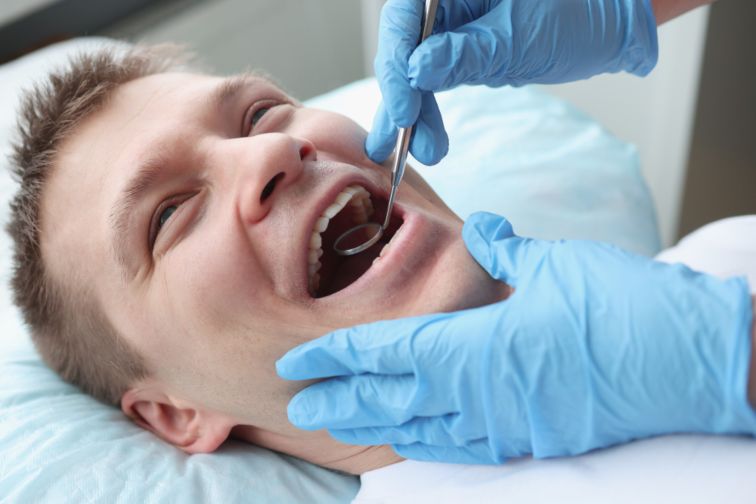The gingival sulcus, also known as free gingiva, is the space where “the gums and teeth meet“, or the natural space between the gum tissue and the surface of the tooth. The Gingival sulcus is a very small V-shaped space around 3 millimetres in depth around the tooth and gums. The cementoenamel junction is located at the bottom of the sulcus, this area helps the gums stay attached to the surface of the teeth.
Normally, the gingival sulcus is snug around the teeth, from the base of the tooth to the point where the tooth emerges from the gums. However, if the gingival sulcus is unhealthy, it is usually a little larger, allowing food particles and other substances to get lodged in the sulcus.
There are many ways to prevent gingival sulcus, the main ones being keeping your teeth clean and regularly visiting your dentist.
Between 1 and 3 millimetres in depth is usually considered normal for the gingival sulcus. If the gingival sulcus depth is more than 4 millimetres, this may be a sign of gum disease. Over a long period of time, the sulcus depth can change due to age or inflammation but should always stay between under 4 millimetres. Measuring sulcus depth helps dentists diagnose gum disease and potential treatments.
Dentists measure the gingival sulcus with a small ruler, which they place right under the gum tissue. The gums are probed and checked for inflammation and the sulcus is measured around each tooth.
The mouth has six parts, called sextants. Three belong to the upper jaw (maxillary arch) and the other three belong to the lower jaw (mandible). The sextants are:
After probing, the dentist will note the appropriate treatment for each sextant, from basic oral hygiene instructions to referring to a specialist for surgery.

Decayed parts on the tooth that can form holes, called cavities, can also affect the gingival sulcus and gums. If the cavity is close enough to the sulcus, pus can form as the body's reaction to bacteria in the cavity. Cavity symptoms can be a toothache, pain when subjected to high or low temperatures, black spots on the tooth or pain when biting.
Gingivitis, also known as periodontal disease or gum disease, is an inflammation of the gums. When talking about the sulcus, food that gets trapped often causes gingivitis. Plaque can also cause gingivitis if it gets its way in the sulcus. Plaque is a soft and colourless substance that sticks around your teeth. It multiplies thanks to the sugar and other food in your saliva. Plaque produces acid along with bacteria in the mouth, which damages the tooth's enamel, and gums and is often linked to bad breath. If left untreated, it can cause severe tooth damage and loss, and can even increase the risk of heart attack, stroke and other health problems.
Gingivitis symptoms can include:
Gingival hyperplasia is the overgrowth of gums around your teeth. A number of causes can be linked with hyperplasia, but more often than not, it’s the result of poor oral hygiene. Inflammation that occurs when there is plaque buildup in the gingival sulcus is one of the most common causes of hyperplasia. Other causes for hyperplasia can be medication like anti-seizure medication, immunosuppressants or calcium channel blockers and even systemic for example pregnancy, hormonal imbalances or leukemia.
If left untreated, hyperplasia can cause misalignment of teeth and increase the risk of developing gum disease. Hyperplasia symptoms can include:

Gingival sulcus diseases are treated depending on the specific issue you have, but it all starts with good oral hygiene. When the gingival sulcus is measured, the sextants are each given a score from 0 to 4, depending on the severity of treatment needed. If the sextant score is 0, that means no treatment is needed, whereas if the score is 4 it requires oral hygiene instructions, cleaning treatments, and evaluation of whether more complex treatment is needed or if a referral to a specialist is needed.
If more complex treatment is needed, a dental practitioner may perform a deep cleaning of the sulcus, to remove any plaque or tartar buildup. Cleaning prevents gum irritation and can include:
Medication can also be used for treatment. Some medication that helps with gum disease is:
If the sulcus damage is severe, the dentist will recommend flap surgery. During flap surgery, the dentist will move the gums back in order to remove any plaque or tartar from pockets and then sew the gums back around the teeth.
The first step to prevent gingival sulcus disease is regular brushing, flossing and visiting the dentist. Flossing should be done with a water flosser, and brushing should be done twice a day with fluoride toothpaste. You should also avoid smoking or any other types of inhaled tobacco or vapour products.
You should consult with your dentist to be sure that your oral hygiene routine is adequate and if it needs correction.

